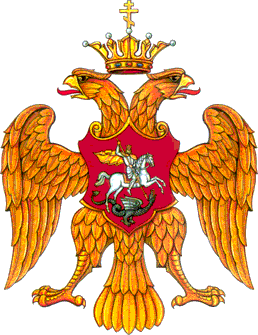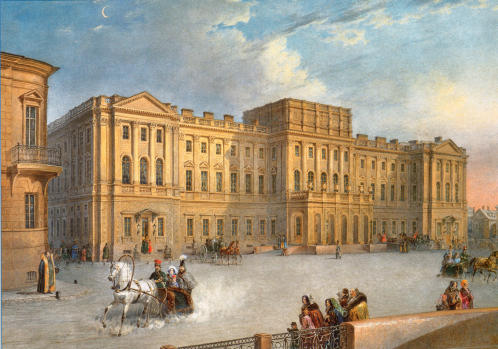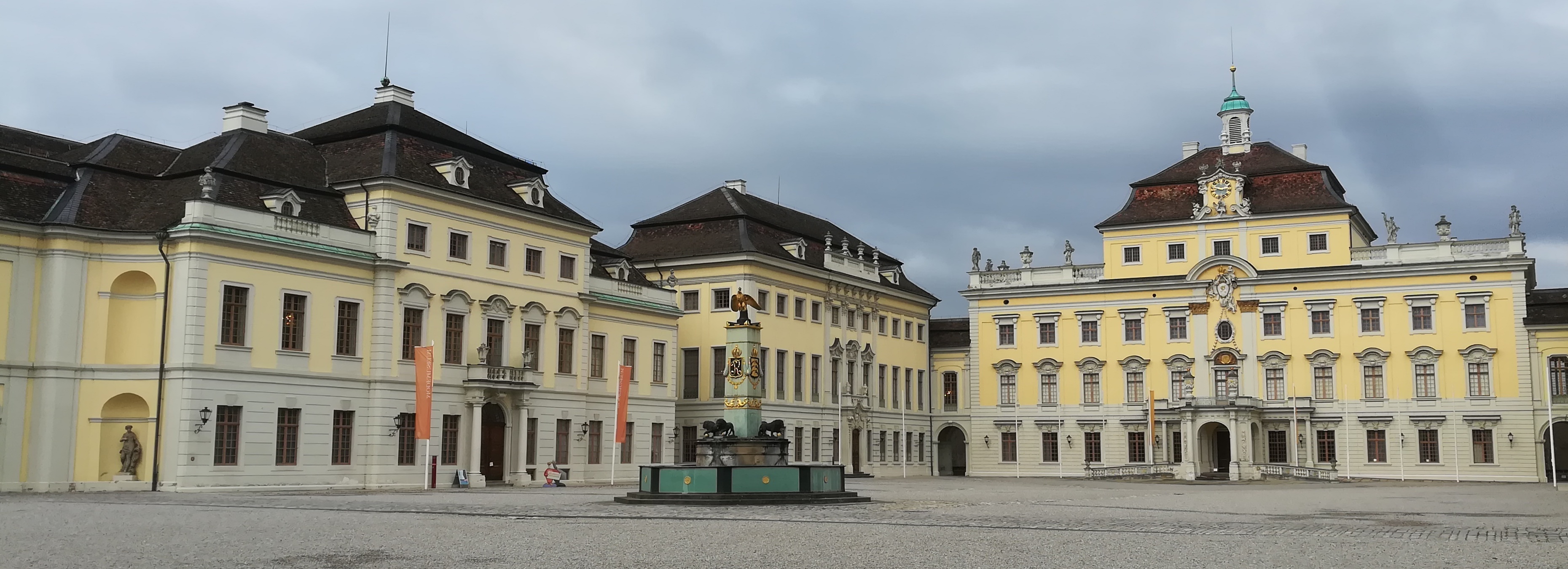|
Nikolai Rumyantsev
Count Nikolai Petrovich Rumyantsev (; 3 April 1754 – 3 January 1826), born in Saint Petersburg, was Russia's Foreign Minister and Chancellor of the Russian Empire in the run-up to Napoleon's invasion of Russia (1808–12). He was the son of Field Marshal Pyotr Rumyantsev-Zadunaisky from the Rumyantsev comital family. Background Rumyantsev and his brother were provided with basic education at home. Their mentor was Friedrich Melchior, Baron von Grimm. In 1774 they went to Leiden University where they studied history, law and language. Official career Rumyantsev was the first envoy of Russia to the Holy Roman Empire after Russia became a guarantor of the imperial constitution through the Treaty of Teschen (1779). He arrived in 1782 accredited as ambassador to the Electoral Rhenish Circle, Upper Rhenish Circle, Swabian Circle, Franconian Circle, Electorate of Mainz, Electorate of Cologne, Palatine Zweibrücken, Duchy of Württemberg, Margraviate of Baden and Landgraviat ... [...More Info...] [...Related Items...] OR: [Wikipedia] [Google] [Baidu] |
Minister Of Foreign Affairs (Russia)
The Minister of Foreign Affairs of the Russian Federation is a high-ranking Russian government official who heads the Ministry of Foreign Affairs of the Russian Federation. The foreign minister is one of the five so-called 'presidential' ministers, along with the ministers of defense, interior, emergencies and justice. Although they are members of the Cabinet, they are directly subordinate to the President. The foreign minister, like other presidential ministers, is nominated and appointed by the President after consultation with the Federation Council (whereas non-presidential ministers are nominated by the Prime Minister and appointed by the President after approval by the State Duma). The foreign minister is also a permanent member of the Russian Security Council. Tsardom of Russia Russian Empire Provisional Government Russian SFSR (1917–1991) Russian Federation (1991–present) See also * Ministry of Foreign Affairs (Russia) * List of Soviet for ... [...More Info...] [...Related Items...] OR: [Wikipedia] [Google] [Baidu] |
Franconian Circle
The Franconian Circle (german: Fränkischer Reichskreis) was an Imperial Circle established in 1500 in the centre of the Holy Roman Empire. It comprised the eastern part of the former Franconian stem duchy—roughly corresponding with the present-day Bavarian ''Regierungsbezirke'' of Upper, Middle and Lower Franconia—while western Rhenish Franconia belonged to the Upper Rhenish Circle. The title of a "Duke of Franconia" was claimed by the Würzburg bishops. Emergence and location As early as the Middle Ages, Franconia had very close links to king and empire. Located between the Rhenish territories of the empire and the Kingdom of Bohemia, Franconia, which included the former Duchy of Franconia, had been one of the centres of empire for a long time. By order of Emperor Louis of Bavaria, Bamberg, Würzburg, Eichstätt and Fulda with the Hohenzollern Burgraves of Nuremberg, Counts of Henneberg, the Castell and Hohenlohe, the three episcopal cities, and the imperial citi ... [...More Info...] [...Related Items...] OR: [Wikipedia] [Google] [Baidu] |
Congress Of Vienna
The Congress of Vienna (, ) of 1814–1815 was a series of international diplomatic meetings to discuss and agree upon a possible new layout of the European political and constitutional order after the downfall of the French Emperor Napoleon Bonaparte. Participants were representatives of all European powers and other stakeholders, chaired by Austrian statesman Klemens von Metternich, and held in Vienna from September 1814 to June 1815. The objective of the Congress was to provide a long-term peace plan for Europe by settling critical issues arising from the French Revolutionary Wars and the Napoleonic Wars without the use of (military) violence. The goal was not simply to restore old boundaries, but to resize the main powers so they could balance each other and remain at peace, being at the same time shepherds for the smaller powers. More fundamentally, strongly generalising, conservative thinking leaders like Von Metternich also sought to restrain or eliminate republicanis ... [...More Info...] [...Related Items...] OR: [Wikipedia] [Google] [Baidu] |
Mikhail Illarionovich Kutuzov
Prince Mikhail Illarionovich Golenishchev-Kutuzov ( rus, Князь Михаи́л Илларио́нович Голени́щев-Куту́зов, Knyaz' Mikhaíl Illariónovich Goleníshchev-Kutúzov; german: Mikhail Illarion Golenishchev-Kutuzov Graf von Smolensk; – ) was a Field Marshal of the Russian Empire. He served as a military officer and a diplomat under the reign of three Romanov monarchs: Empress Catherine II, and Emperors Paul I and Alexander I. Kutuzov was shot in the head twice while fighting the Turks (1774 and 1788) and survived the serious injuries seemingly against all odds. He defeated Napoleon as commander-in-chief using attrition warfare in the Patriotic war of 1812. Alexander I, the incumbent Tsar during Napoleon's invasion, would write that he would be remembered amongst Europe's most famous commanders and that Russia would never forget his worthiness. Early career Mikhail Kutuzov was born in Saint Petersburg on 16 September 1745. His father, Lie ... [...More Info...] [...Related Items...] OR: [Wikipedia] [Google] [Baidu] |
State Council Of Imperial Russia
The State Council ( rus, Госуда́рственный сове́т, p=ɡəsʊˈdarstvʲɪn(ː)ɨj sɐˈvʲet) was the supreme state advisory body to the Tsar in Imperial Russia. From 1906, it was the upper house of the parliament under the Russian Constitution of 1906. 18th century Early Tsars' Councils were small and dealt primarily with external politics. Peter I of Russia introduced the Secret Council. Catherine I of Russia introduced the Supreme Secret Council. Its role varied during different reigns. Peter III of Russia created the Imperial Council on 20 May 1762 ("Императорский Совет"), or, formally "The Council at the Highest Court" ("Совет при высочайшем дворе"). It was dismissed shortly after the succession of Catherine II of Russia. 1810–1906 The State Council was established by Alexander I of Russia in 1810 as part of Speransky's reforms. Although envisaged by Speransky as the upper chamber of the Russian parliament ... [...More Info...] [...Related Items...] OR: [Wikipedia] [Google] [Baidu] |
Maria Feodorovna (Sophie Dorothea Of Württemberg)
Maria Feodorovna (russian: Мария Фёдоровна; née Duchess Sophie Dorothea of Württemberg; 25 October 1759 – 5 November 1828 S 24 October became Empress consort of Russia as the second wife of Emperor Paul I. She founded the Office of the Institutions of Empress Maria. Daughter of Duke Frederick Eugene of Württemberg and Princess Friederike of Brandenburg-Schwedt, Sophie Dorothea belonged to a junior branch of the House of Württemberg and grew up in Montbéliard, receiving an excellent education for her time. After Grand Duke Paul (the future Paul I of Russia) became a widower in 1776, King Frederick II of Prussia (Sophie Dorothea's maternal great-uncle) and Empress Catherine II of Russia chose Sophie Dorothea as the ideal candidate to become Paul's second wife. In spite of her fiancé's difficult character, she developed a long, peaceful relationship with Paul and converted to the Russian Orthodox Church in 1776, adopting the name ''Maria Feodorovna''. Durin ... [...More Info...] [...Related Items...] OR: [Wikipedia] [Google] [Baidu] |
Alexander I Of Russia
Alexander I (; – ) was Emperor of Russia from 1801, the first King of Congress Poland from 1815, and the Grand Duke of Finland from 1809 to his death. He was the eldest son of Emperor Paul I and Sophie Dorothea of Württemberg. The son of Grand Duke Paul Petrovich, later Paul I, Alexander succeeded to the throne after his father was murdered. He ruled Russia during the chaotic period of the Napoleonic Wars. As prince and during the early years of his reign, Alexander often used liberal rhetoric, but continued Russia's absolutist policies in practice. In the first years of his reign, he initiated some minor social reforms and (in 1803–04) major liberal educational reforms, such as building more universities. Alexander appointed Mikhail Speransky, the son of a village priest, as one of his closest advisors. The Collegia were abolished and replaced by the State Council, which was created to improve legislation. Plans were also made to set up a parliament and sign a con ... [...More Info...] [...Related Items...] OR: [Wikipedia] [Google] [Baidu] |
Habsburg Monarchy
The Habsburg monarchy (german: Habsburgermonarchie, ), also known as the Danubian monarchy (german: Donaumonarchie, ), or Habsburg Empire (german: Habsburgerreich, ), was the collection of empires, kingdoms, duchies, counties and other polities that were ruled by the House of Habsburg, especially the dynasty's Austrian branch. The history of the Habsburg monarchy can be traced back to the election of Rudolf I as King of Germany in 1273 and his acquisition of the Duchy of Austria for the Habsburg in 1282. In 1482, Maximilian I acquired the Netherlands through marriage. Both realms passed to his grandson and successor, Charles V, who also inherited the Spanish throne and its colonial possessions, and thus came to rule the Habsburg empire at its greatest territorial extent. The abdication of Charles V in 1556 led to a division within the dynasty between his son Philip II of Spain and his brother Ferdinand I, who had served as his lieutenant and the elected king of Hungary a ... [...More Info...] [...Related Items...] OR: [Wikipedia] [Google] [Baidu] |
Landgraviate Of Hesse-Kassel
The Landgraviate of Hesse-Kassel (german: Landgrafschaft Hessen-Kassel), spelled Hesse-Cassel during its entire existence, was a state in the Holy Roman Empire that was directly subject to the Emperor. The state was created in 1567 when the Landgraviate of Hesse was divided upon the death of Philip I, Landgrave of Hesse. His eldest son William IV inherited the northern half of the Landgraviate and the capital of Kassel. The other sons received the Landgraviate of Hesse-Marburg, the Landgraviate of Hesse-Rheinfels and the Landgraviate of Hesse-Darmstadt. During the Napoleonic reorganisation of the Empire in 1803, the Landgrave of Hesse-Kassel was elevated to an Electorate and Landgrave William IX became an Imperial Elector. Many members of the Hesse-Kassel House served in the Danish military gaining high ranks and power in the Oldenburg realm due to the fact that many Landgraves were married to Danish princesses. Members of the family who are known to have served Denmark- ... [...More Info...] [...Related Items...] OR: [Wikipedia] [Google] [Baidu] |
Margraviate Of Baden
The Margraviate of Baden (german: Markgrafschaft Baden) was a historical territory of the Holy Roman Empire. Spread along the east side of the Upper Rhine River in southwestern Germany, it was named a margraviate in 1112 and existed until 1535, when it was split into the two margraviates of Baden-Durlach and Baden-Baden. The two parts were reunited in 1771 under Margrave Charles Frederick, even if the three parts of the State maintained their distinct seats to the Reichstag.Votes number 58 Baden, 60 Durlach, 62 Höchberg. The restored Margraviate of Baden was elevated to the status of electorate in 1803. In 1806, the Electorate of Baden, receiving territorial additions, became the Grand Duchy of Baden. The rulers of Baden, known as the House of Baden, were a cadet line of the Swabian House of Zähringen. History During the 11th century, the Duchy of Swabia lacked a powerful central authority and was under the control of various comital dynasties, the strongest of them being ... [...More Info...] [...Related Items...] OR: [Wikipedia] [Google] [Baidu] |
Duchy Of Württemberg
The Duchy of Württemberg (german: Herzogtum Württemberg) was a duchy located in the south-western part of the Holy Roman Empire. It was a member of the Holy Roman Empire from 1495 to 1806. The dukedom's long survival for over three centuries was mainly due to its size, being larger than its immediate neighbors. During the Protestant Reformation, Württemberg faced great pressure from the Holy Roman Empire to remain a member. Württemberg resisted repeated French invasions in the 17th and 18th centuries. Württemberg was directly in the path of French and Austrian armies who were engaged in the long rivalry between the House of Bourbon and the House of Habsburg. In 1803, Napoleon raised the duchy to be the Electorate of Württemberg of the Holy Roman Empire. On 1 January 1806, the last Elector assumed the title of King of Württemberg. Later that year, on 6 August 1806, the last Emperor, Francis II, abolished (de facto) the Holy Roman Empire. Geography Much of the territor ... [...More Info...] [...Related Items...] OR: [Wikipedia] [Google] [Baidu] |






